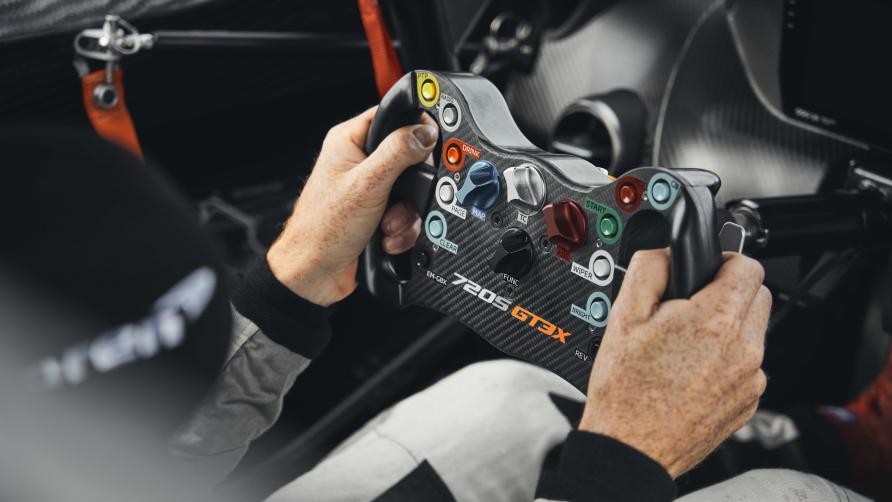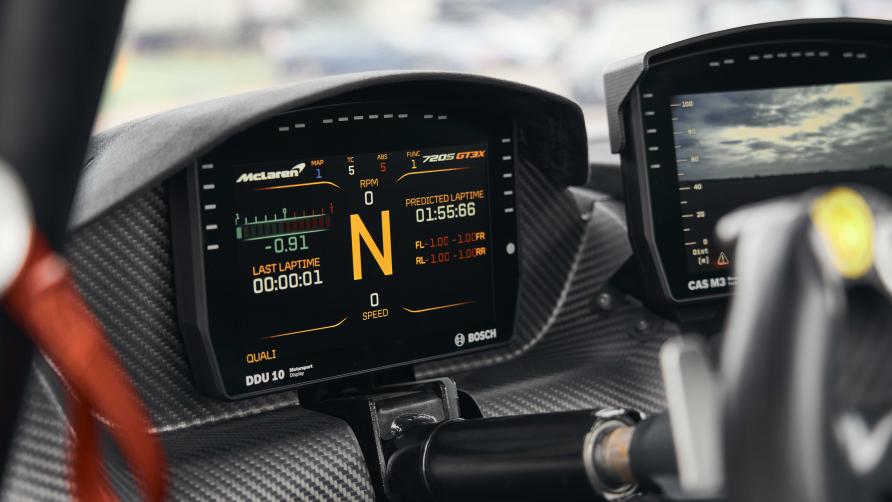I thought I knew what I was getting into here. And as I squeezed past scaffolding poles and nestled into the seat’s tight grip there was no doubt in my mind. Definitely a McLaren 720S GT3X. Says so on the steering wheel. Metaphorically, though? Well I thought I had that dialled too, but when I started moving it all came a bit unstuck.

Here’s the thing no one tells you about GT3 racing cars. They’re not very fast. Sure, they’ll turn in impressive lap times, but that’s because they have slick tyres, astonishing brakes and lateral grip that would make a limpet raise an eyebrow. But when we say fast we mean acceleration don’t we? However, to make the racing even and to keep costs down, power is limited. It’s all done electrically these days – no inlet restrictors, but instead turbo boost management. Total output? Somewhere in the region of 500–550bhp.

Two issues with that. First, having physically brutalised yourself with the stopping and turning in your GT3 car, when you accelerate it’s like you’ve left the handbrake on. Second, it seems a bit daft that the road car has 200bhp more and would romp away from the racer in a straight-line drag race.
This, the GT3X, is the ‘what if?’ GT3 car. No limits, restore some balance. Fifty per cent of the components are different from the racecar’s, 90 per cent changed from an original 720S road car. It never was a road car. A bare chassis and necessary carry-over bits go to an individual build bay at race team HQ and the car is constructed from there. It runs the same aero package as the GT3 racer, weighs a little less, has a modified roll cage (chiefly to allow the inclusion of a passenger seat) and a load more power.

The engine is the big change. Where the racer uses a different V8 that McLaren will only tell me is “from elsewhere in our stable”, the GT3X reverts to the regular road car’s M840T twin-turbo V8. And then goes to work on it. Strengthened pistons are fitted, also a lightweight exhaust and blueprinted cylinder head. Power delivery is changed, low rev tractability suffering in favour of high rev power and response. There’s also a push-to-pass button that frees up another 30bhp. All the body panels are carbon, and the options list includes such niceties as a drinks system – a straw, rather than a cabinet – full telemetry and a silenced exhaust.

Which, to limit noise, is what we’re running at Dunsfold today. This very car ran at the Goodwood Festival of Speed back in the summer with two notable achievements. It was the absolute fastest car up the hill, winning the overall shoot-out. And you could hear it pretty much the whole way up.
Basically it’s a GT3 with 50 per cent more power. So in my head that meant it would just be faster in a straight line. Fine, I can cope with that. McLaren reckons it’ll do 0–60mph wearing slicks in 2.8secs and that’s fine too, because I’m not long out of the Ferrari SF90 having posted a 2.35secs two-way average. But what I’d forgotten is break times. No, not brake times. In a regular GT3, acceleration is when you have a rest. In the GT3X, that’s gone, the physical forces on your body are not only more punishing, but the time spent actually covering a straight is much reduced.
The acceleration never lets up. From Chicago down to Hammerhead I chance a glance at the digi readout and see it at, er, well, I think it was either 235kph or 238kph. Could be wrong, there was quite a lot going on. But let’s say about 145mph, when most superfast road cars struggle to hit 125 (less speed carried out of Chicago, earlier on the brakes into Hammerhead).

The extra power taxes the car everywhere. You arrive at braking zones faster, you have to be more cautious with the throttle mid-corner, it means the car is on a finer edge all the time. It’s bloody exhausting. But this is how it should be. I’ve driven other GT3 cars and they’ve always left me slightly hollow. I get out of them convinced the engineers have fitted the special restricted engine map labelled ‘foolproof: journo mode’. They insist not, tell me that’s how fast a GT3 car is and I go away mildly dejected.
The GT3X is different. Wilder. Way more intense. Equipped with the muscle to fight back against slick tyres, wings and devastating, face-wrenching brakes. So we gave it to Stig.
And only 1min 07.2secs later he was back. Four whole seconds faster than the current leaderboard champ, Ferrari’s SF90. But the GT3X is not road legal, so is not eligible. Nor can it race – the changes mean it’s not allowed.
So what’s it for? Number one answer: wealthy people to do track days. McLaren Racing will build you one at a cost of £750,000. But hang on, you’re thinking, doesn’t McLaren already have a track-only hypercar? Yes, it does. There was the P1 GTR, then the Senna GTR – so why bother doing this?
I detect a trace of internal politics here. Imagine you’re McLaren’s race team. You’ve watched as the production car people have launched increasingly track focused cars, culminating in those GTRs. “Hang about,” you think… “track cars are our department.” And so you decide to get one over on them.

This feels the more genuine machine to me. The way it remains so balanced when you charge into corners heavy on the brakes, the way the suspension packs such fluency into so little travel. A Senna GTR is both lighter and yet more powerful, but I found this easier to manage, more predictable and more communicative. Helped that I knew the track so well.
I drove the Senna GTR in Bahrain at night, gave myself (and my poor instructor) a massive moment with a huge slide through Turn 13. No such moments at Dunsfold, although I did come away with bruised hips that had me swaying along like John Wayne for a couple of hours, plus formidable sweat levels. Serves me right. Like I said, I thought I knew what I was getting into. I underestimated the relentless 720S GT3X. I was wrong.







